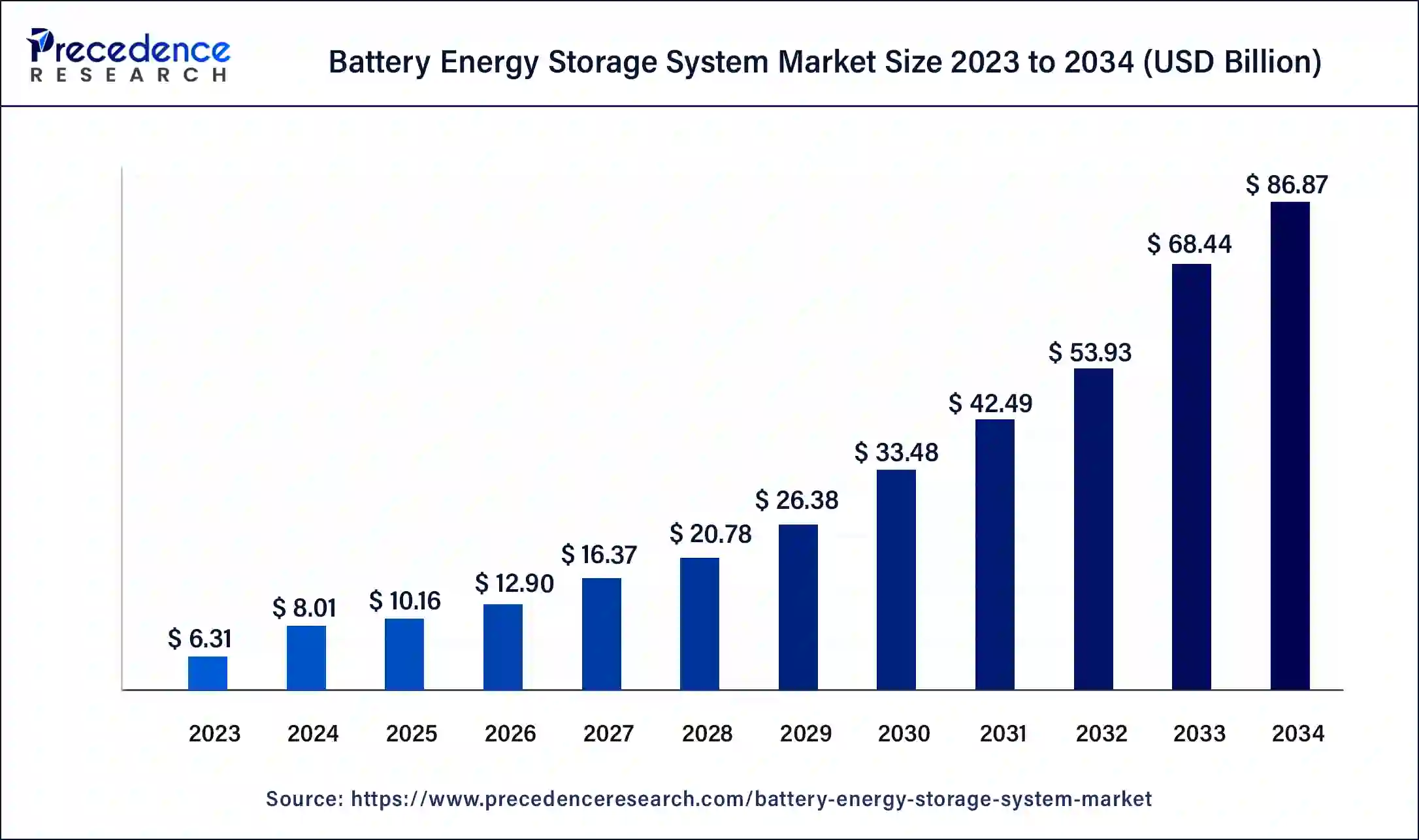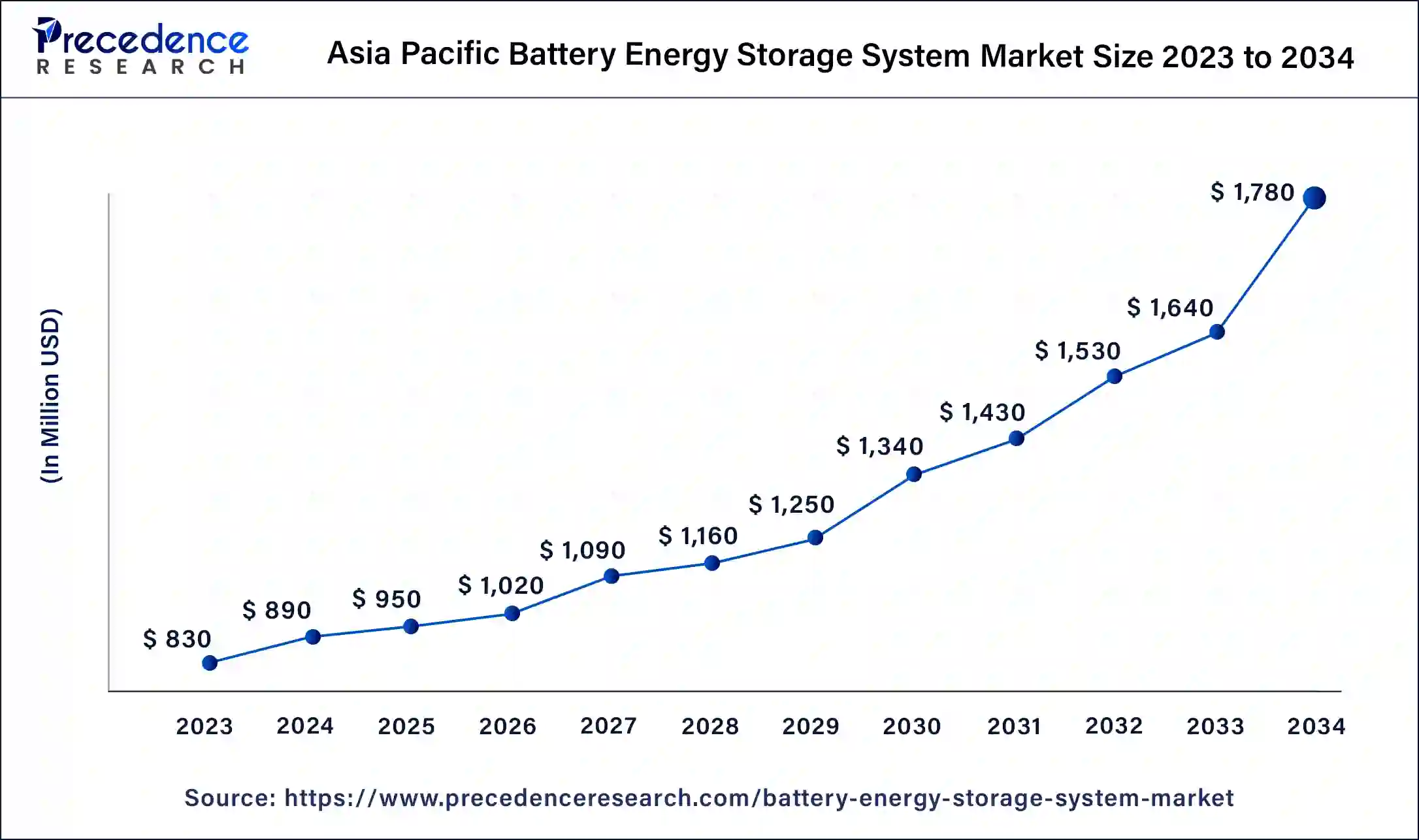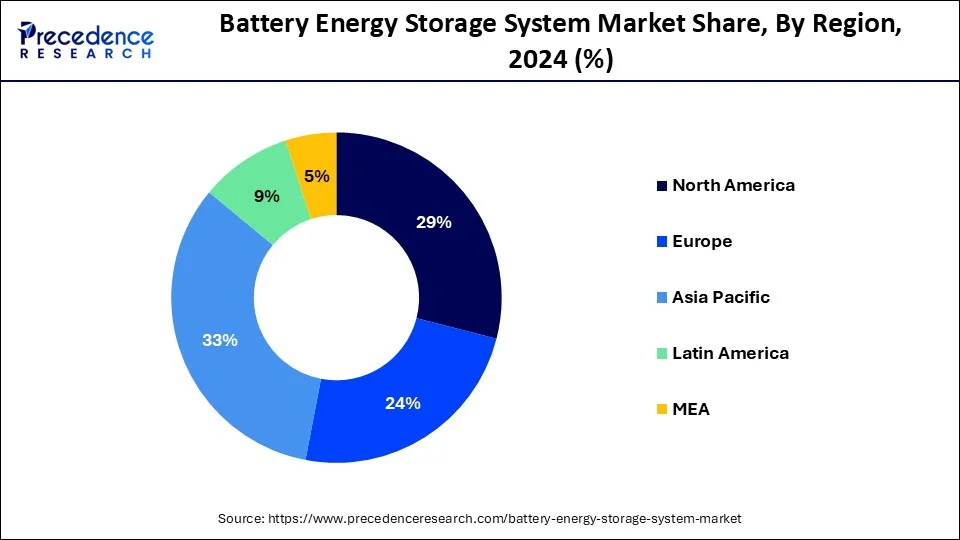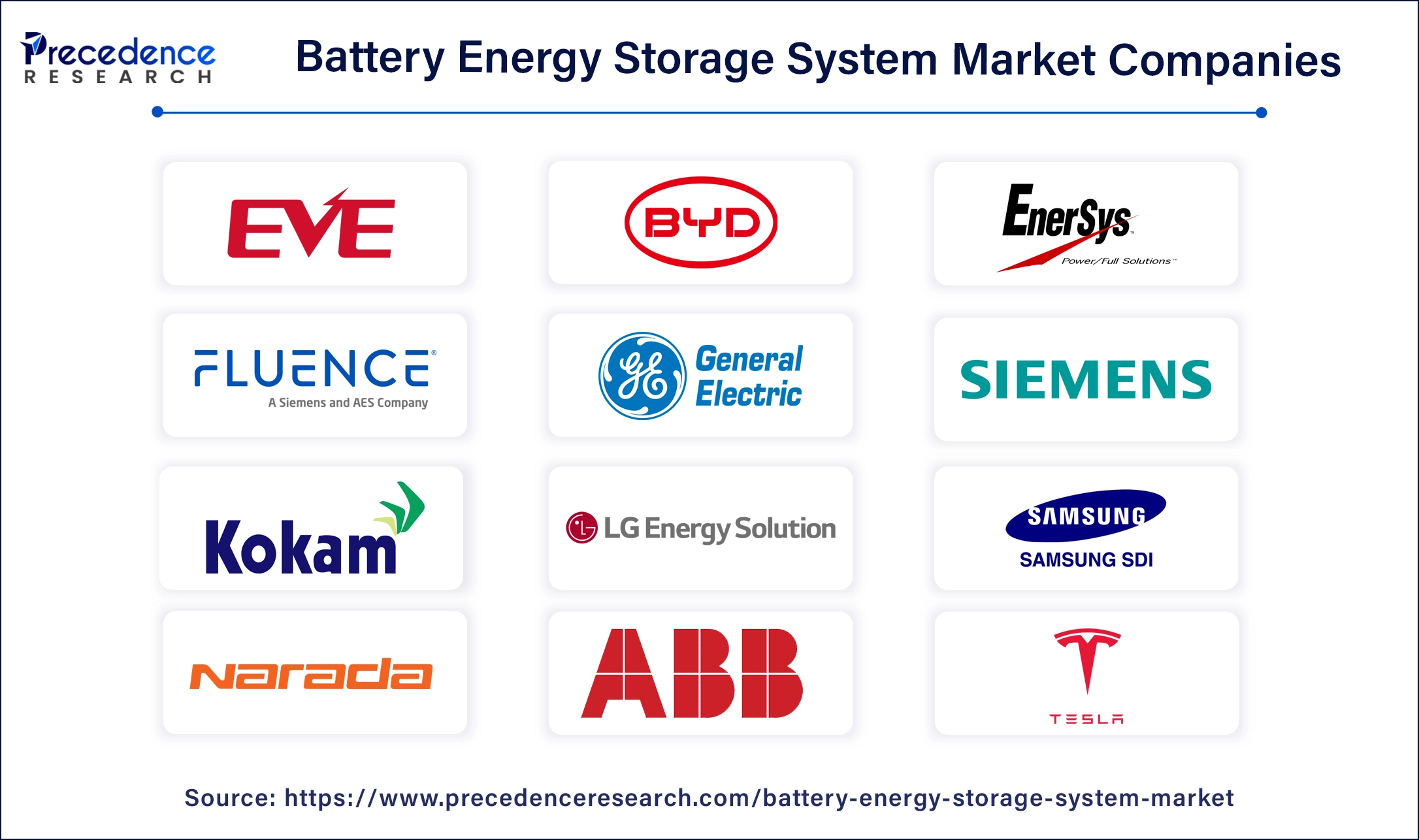What is the Battery Energy Storage System Market Size?
The global battery energy storage system market size is calculated at USD 10.16 billion in 2025 and is predicted to increase from USD 12.90 billion in 2026 to approximately USD 86.87 billion by 2034, expanding at a solid CAGR of 26.92% over the forecast period 2025 to 2034. Inclination towards renewable energy sources, with sustainability and a global push towards energy consumption is propelling the batteryenergy storage system market.

Battery Energy Storage System Market Key Takeaways
- In terms of revenue, the battery energy storage system market is valued at $10.16 billion in 2025.
- It is projected to reach $86.87 billion by 2034.
- The battery energy storage system market is expected to grow at a CAGR of 26.92% from 2025 to 2034.
- Asia Pacific dominate the battery energy storage system market with the largest market share of 33% in 2024.
- North America is anticipated to grow at a significant rate in the global market over the studied period.
- By battery, the lithium-ion batteries segment dominated the global market in 2024.
- By battery, the flow batteries segment is anticipated to witness the fastest growth in the market during the forecast period.
- By battery, the advanced lead acid batteries segment is expected to witness a surge in demand in the market during the forecast period.
- By connection type, the on-grid connection segment held the largest share of the market in 2024.
- By ownership, the utility-owned segment led the global market in 2024.
- By application, the residential segment is anticipated to witness the fastest growth in the market during the forecast period.
Market Overview
The global battery energy storage system market is witnessing substantial growth owing to various factors and is anticipated to continue its growth rate over the forecasted years. Major attributions to this growth are the inclination towards sustainable and renewable energy products, grid stability necessity, and technological advancement for energy preservation, which has fuelled the growth of the market globally.
From a geographical standpoint, Asia Pacific holds significant shares in the battery energy storage system market owing to the major key players in the energy sector based in the region. Furthermore, increasing demand for renewable energy sources encourages competitors in the market to launch technically sound battery energy storage systems to improve longevity.
- In April 2023, TESLA Inc., a Renowned global enterprise, announced its plan to build a gigafactory in China. This will aid in manufacturing a Megapack, an Energy storage product, strengthening its position in the energy preservation sector.
- According to IEA, a France-based intergovernmental agency, the global renewable electricity capacity is estimated to be preserved at up to 4800 GW by the end of 2026.
Battery Energy Storage System Market Growth Factors
- The global shift towards renewable energy sources drives the growth of the battery energy storage system market.
- The battery energy storage system market is experiencing growth due to a rising need for grid stability for uninterrupted power supply.
- Increasing investment by major key players for the grid's technological advancement.
- Rising support and launch of different policies by governments around the world to support energy preservation.
- Changing the cost of lithium-ion type batteries from higher rates to reasonable rates, fuelling the expansion of the battery energy storage system market.
- Strategic partnerships and acquisitions between key players in the battery energy storage system market.
Market Scope
| Report Coverage | Details |
| Market Size by 2034 | USD 86.87 Billion |
| Market Size in 2025 | USD 10.16 Billion |
| Market Size in 2026 | USD 12.90 Billion |
| Market Growth Rate from 2025 to 2034 | CAGR of 26.92% |
| Largest Market | Asia Pacific |
| Base Year | 2025 |
| Forecast Period | 2025 to 2034 |
| Segments Covered | Battery Type, Connection Type, Ownership, Application and Regions |
| Regions Covered | North America, Europe, Asia-Pacific, Latin America, and Middle East & Africa |
Market Dynamics
Driver
Increasing grid modernization for sustainable power supply
One of the major driving factors for the battery energy storage system market is the deployment of energy storage systems in existing grid systems. Efforts have been put into the modernization of the grid system and integrating it with renewable energy sources power grid like wind and solar power stations. Though these systems are efficient for power generation and abundantly available in nature, they hold the potential to disrupt at any time due to various environmental factors. Hence, extra grids are necessary to install to store extra energy where it can be used in peak hours or at the time of power shortages. Installing these extra grids ensures the stability of the energy supply that will not damage equipment under fluctuations in the power supply if they happen at any instant.
Restraint
High-cost lithium-ion batteries
The significant restraint for the battery energy storage system could be major upfront investments to hold the technologies like lead acid batteries and lithium-ion batteries owing to their high energy capacity, which eventually helps in better performance. Despite having expensive costs, lithium-ion batteries provide high energy density and minimum maintenance; hence, these batteries are commonly used in EVS due to their large capacity, small size, and lightweight nature.
To support EV battery's shelf life, proper conservation and storage are required. A robust infrastructure is needed for material installations and components storage, which further increases the overall cost of the battery energy storage system. Hence, in a nutshell, maintenance of lithium-ion batteries could hinder market growth. However, with technological maturity and an ongoing period, the cost of lithium-ion batteries poses a reduction in the market.
Opportunity
The surge in EV adoption
A significant opportunity for the battery energy storage system market is an inclination toward the globally rapid adoption of electric vehicles. EVs use batteries to operate, and they are powered by electric motors as well, which solely depend upon energy stored in the batteries and storage devices built in them. These batteries release energies while driving that were obtained from charging stations that aid in reducing the dependency on combustion engines to operate vehicles. It eventually helps in lowering carbon emissions by not using fossil fuels for the combustion of engines and further supports the market while increasing sales of EVs globally.
- According to the data released by the IEA-international Energy Agency, In May 2022, the total sales of EVs increased around twice that in the past year, with more than 1.9 million electric cars sold globally was noted in 2022.
Battery Insights
The lithium-ion batteries segment dominated the global battery energy storage system market in 2024. The growth of this segment is related to a number of factors, which include increasing spending on building a robust infrastructure by major players in the commercial as well as residential fields. Lithium-ion battery shows a tremendous benefit in terms of storage capacity, longevity, lighter weight, and reasonable cost, plus lower coverage area.
Owing to its advantages, many governments are owed to deploy structural facilities to support the production of lithium-ion batteries and, eventually, their storage system. Authorities in the energy sector are trying to mitigate environmental damage caused by emissions from energy sectors. For this reason, lithium-ion battery plays a crucial role, and thus, their storage system is bound to proliferate in the battery energy storage system market globally.
The flow batteries segment is anticipated to witness the fastest growth in the battery energy storage system market during the forecast period, owing to its ability to provide a continuous and uninterrupted energy supply. Again, in terms of energy and response, this technology offers instantaneous and regulated output, which leads to improved quality for overall operation. It is, therefore, cost-effective as it has longer service and a lower rate of maintenance.
The advanced lead acid batteries segment is expected to witness a surge in demand in the battery energy storage system market during the forecast period. the major growth factor of this segment is that it requires low-tech equipment to manufacture. Thus, it has a cheaper cost rate than other batteries in the market. This can be beneficial to SMEs where the financial budget might be concerned with anything.
Connection Type Insights
The on-grid connection segment held the largest share of the battery energy storage system market in 2024. The growth of this segment has many facets. On-grid connection plays a crucial role since it is used to stabilize the main power grid and to manage sudden changes in demand. This system also aids in the efficient integration of renewable energy sources. Sources could probably be wind and power generators.
Ownership Insights
The utility-owned segment led the global battery energy storage system market in 2024. The growth of this segment is attributed to the rising need for grid stability, and regulatory bodies have set rules to reduce carbon emissions.
The European Union allotted substantial funds to improve the energy storage system and increase its capacity under the plan called REPowerEU.
Application Insights
The residential segment is anticipated to witness the fastest growth in the battery energy storage system market during the forecast period. The residential segment of the global market is experiencing growth due to declining costs of battery technologies, government incentives, and increased awareness of climate change. The rising adoption of solar PV systems and homeowners' desire for energy independence are driving factors behind this growth.
Regional Insights
Asia Pacific Battery Energy Storage System Market Size and Growth 2025 to 2034
The U.S. battery energy storage system market size is exhibited at USD 3.35 billion in 2025 and is projected to be worth around USD 29.10 billion by 2034, poised to grow at a CAGR of 27.12% from 2025 to 2034.

Asia Pacific accounted for the largest share of the battery energy storage system market in 2024. The growth of this market in Asia Pacific is due to rapid urbanization and the increasing population's need for uninterrupted power supply for residential and commercial uses. Most developing countries fall under this region, which is another key factor that proceeds the market. To increase the grid's flexibility and improve its performance, grid operators started installing battery energy storage systems.
In the battery energy storage system market, developing countries like India, China, and Japan are witnessing increasing birth rates. Thus, overall population needs, which include energy consumption with uninterrupted power supply, further fuel the market growth in Asia Pacific. For battery storage deployment, China is registered as a well-established country. The growth of this country in the battery storage system market is due to greater technological advancement in the past few decades.

North America is anticipated to grow at a significant rate in the global battery energy storage system market over the studied period. The growth of this region is majorly dependent upon the contribution of the U.S. in the energy sector.
- In January 2022, Franklin Whole Home, a privately funded cleantech company based in the United States, introduced an innovative integrated battery and control system leveraging artificial intelligence technology. The Franklin Home Power solution stands out by combining lithium iron phosphate with aGate smart control technology, resulting in a distinctive and improved storage solution.
In the battery energy storage system market, countries such as Canada have well-established energy markets, and energy preservation is the top priority of the governments in this region. Therefore, it becomes imperative in the north to follow all the safety guidelines and energy conservation rules for monitoring the energy storage system. These markets also follow the rules for the transmission of energy, power generation, and carbon credits to reduce GHG emissions in the region. The United States and Canada are the major shareholders and contributors to the battery energy storage system market.
Battery Energy Storage System Market Companies

- EnerSys
- BYD Company Limited
- EVE Energy
- Siemens AG
- LG Energy Solutions
- Kokam
- Narada Asia Pacific
- ABB Ltd.
- Tesla
- Fluence Energy
- General Electric
- TotalEnergies
- Tata Power Company Limited
- Samsung SDI
- Nissan Motor
- VRB Energy and Black & Veatch Holding Company
Recent Developments
- In March 2025, Atlas Copco launched a 1 MW battery energy storage system, the ZBC 1000-1200, which delivers 1 MW of power from a single unit. The new ZBC 1 MW is built using the same advanced battery technology as Atlas Copco's existing range of ESS to deliver a reliable source of power and enable users to reduce emissions by up to 90% while saving on costs. (Source: https://im-mining.com)
- In May 2025, ABB today announced the launch of its new Battery Energy Storage Systems-as-a-Service (BESS-as-a-Service), a flexible, zero-CapEx solution designed to accelerate the shift to clean, resilient, and affordable energy. BESS-as-a-Service is the first in a range of next-generation service models being developed to remove the barriers to clean technology adoption and accelerate industries' transition to net zero. (Source: https://new.abb.com)
- In May 2025, WEG, a global leader in energy and automation solutions, unveiled a cutting-edge utility-scale battery energy storage system (BESS) in Europe. This inclusive energy storage and management solution addresses the growing demand for reliable, efficient, and sustainable energy systems, offering unparalleled flexibility for integration into a wide range of applications. (Source: https://www.pandct.com)
- In May 2025, PURE launched its battery-based 5 MWh grid storage product, PuREPower Grid, in Delhi. PuREPower Grid is built with high energy density batteries, 5th-generation power electronics, and cloud & predictive AI for seamless remote monitoring and 100 percent uptime. (Source: https://www.manufacturingtodayindia.com)
Segments Covered in the Report
By Battery Type
- Lithium-ion Battery
- Lead Acid Battery
- Flywheel Battery
- Other Battery Types
By Connection Type
- On-grid
- Off-grid
By Ownership
- Customer-owned
- Third-party Owned
- Utility-owned
By Application
- Residential
- Commercial
- Utility
By Region
- North America
- Asia Pacific
- Europe
- Latin America
- Middle East & Africa
For inquiries regarding discounts, bulk purchases, or customization requests, please contact us at sales@precedenceresearch.com
Frequently Asked Questions
Ask For Sample
No cookie-cutter, only authentic analysis – take the 1st step to become a Precedence Research client
 sales@precedenceresearch.com
sales@precedenceresearch.com
 +1 804-441-9344
+1 804-441-9344